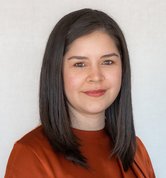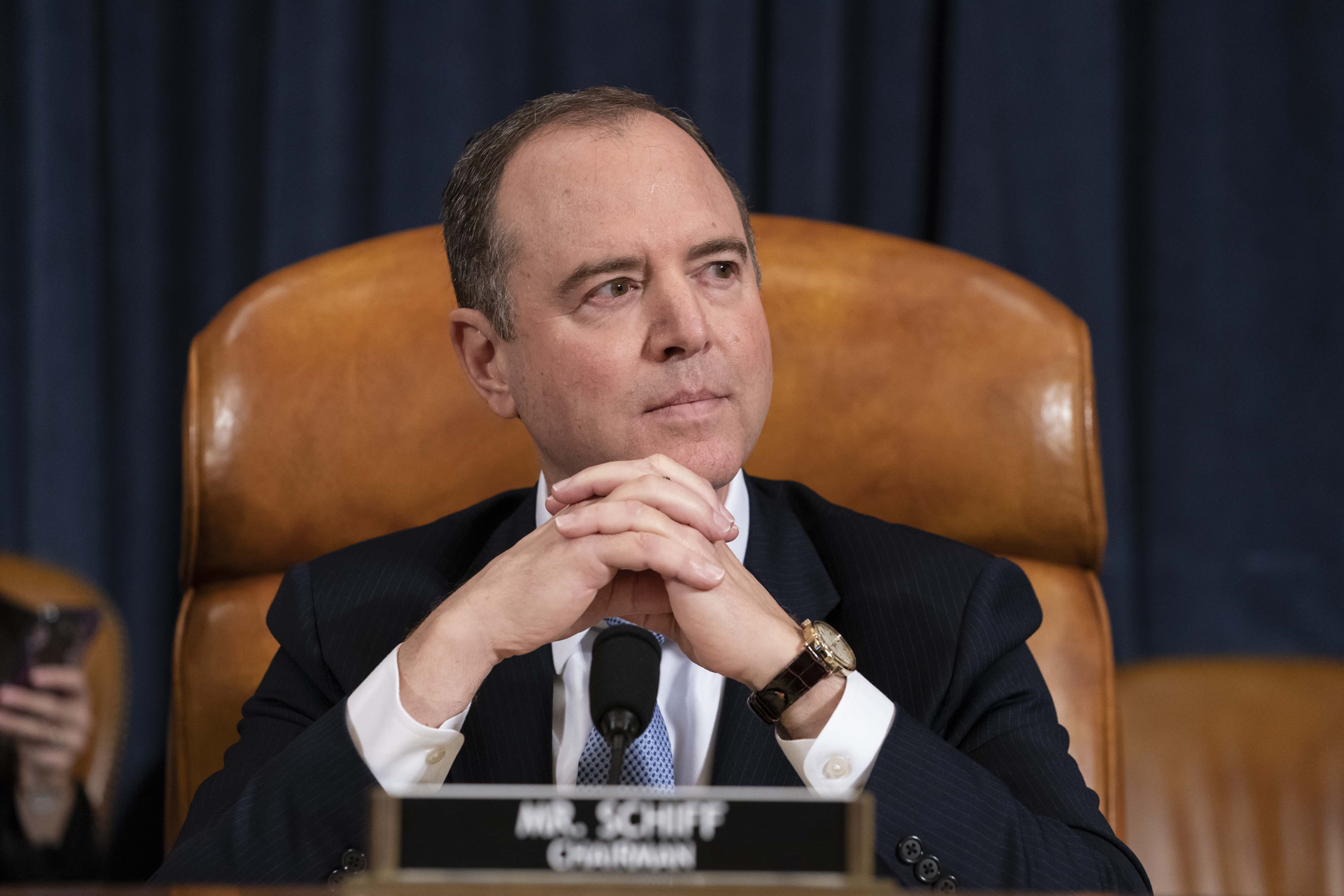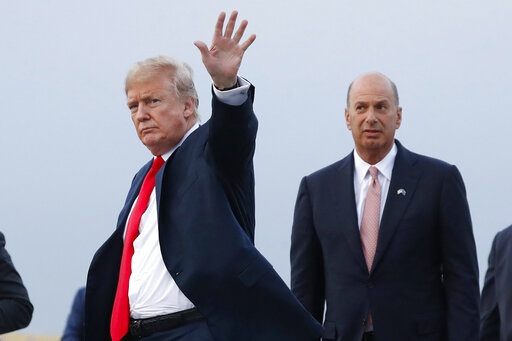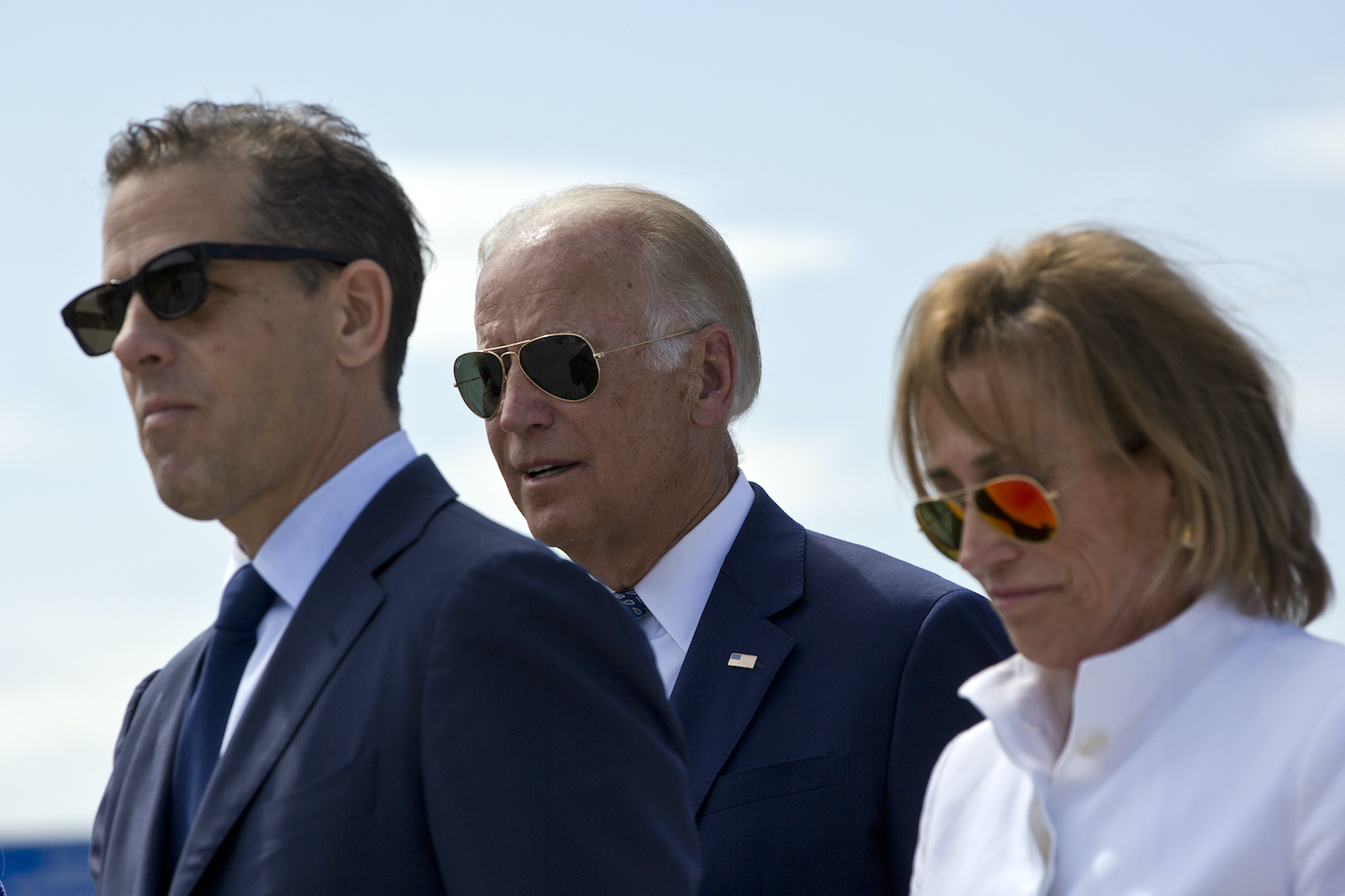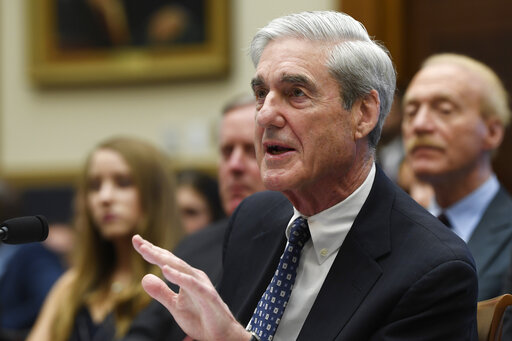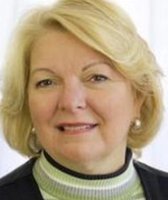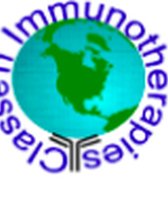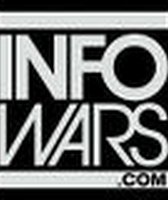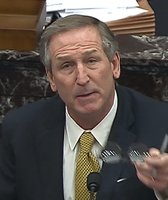Stand up for the facts!
Our only agenda is to publish the truth so you can be an informed participant in democracy.
We need your help.
I would like to contribute
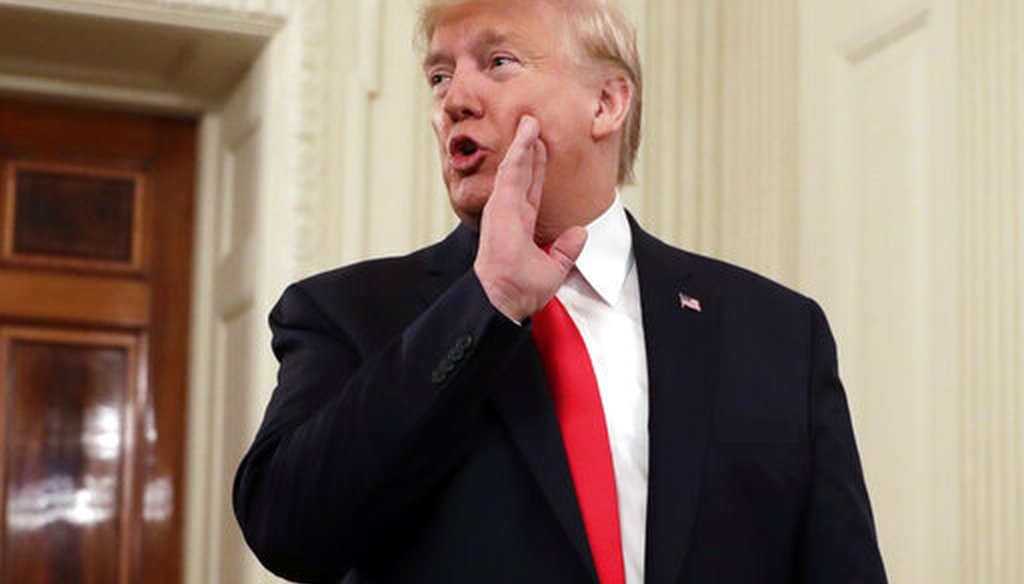
President Donald Trump talks to the media during the NCAA Collegiate National Champions Day event at the White House, Friday, Nov. 22, 2019, in Washington. (AP)
President Donald Trump responded to a week of impeachment hearings with a nearly one-hour interview on Fox & Friends. Many of his points were either inaccurate or repeated debunked conspiracy theories.
He claimed it was Ukraine that interfered with the 2016 election. But American intelligence officials say that is a conspiracy theory.
He said he released details of his call with Ukrainian President Volodymyr Zelensky to show how Democrat Adam Schiff made up his own version. But Trump released the call readout before — not after — Schiff discussed it in a public hearing.
RELATED: Impeachment is underway, the election is one year away and political fact-checking is needed now more than ever. Today, your donation to PolitiFact is tripled.
He asked why Europe isn’t providing aid to Ukraine. But they have committed $15 billion.
He said he doesn’t like the phrase "deep state." But he used the phrase at political rallies in Louisiana and Kentucky this month.
Here are 14 things Trump said that were either wrong or need additional context.
Whistleblower didn't create "fake story" | No evidence Yovanovitch didn't hang Trump's photo | Trump does know Gordon Sondland | Mueller found nothing? Not so fast
This is a conspiracy theory.
Broadly, the words "Crowdstrike" and "server" are tied to a theory claiming that Crowdstrike, an American cybersecurity firm, hid a server containing Hillary Clinton emails in Ukraine. That theory conflates work Crowdstrike did for the Democratic National Committee related to a 2016 breach in its servers, and Clinton’s deleted emails from a private email server she used when she was Secretary of State.
Trump didn’t make clear who is the "they" he had in mind here. But this is something he also brought up in his July call with Zelensky.
The DNC hired Crowdstrike in May 2016 to investigate a breach in its servers. In October 2016, the U.S. intelligence community said it was confident that Russia was behind the DNC hack, and that it reached its conclusion partially with the help of Crowdstrike’s audit of the DNC servers. We’ve found no evidence that Crowdstrike ever worked on issues around Clinton’s private email server.
Part of the conspiracy hinges on the fact that the FBI did not directly review the hacked hardware, leaving the property under the control of its owners. In his March 2017 testimony to the House Intelligence Committee, former FBI Director James Comey said the agency accessed a review of the system conducted by Crowdstrike.
We previously found no evidence that investigating the server copy would have prevented the FBI from tracking down the hackers.
One more thing: Crowdstrike isn’t owned by a wealthy Ukrainian. Crowdstrike is owned by California-based Crowdstrike Holdings, Inc. The company was co-founded by chief executive George Kurtz, chief technology officer Dmitri Alperovitch and Gregg Marston (now retired) in 2011. Conspiracists claim Alperovitch is Ukrainian. He isn’t. He’s an American citizen born in Russia.
— Daniel Funke and Miriam Valverde
House Intelligence Committee Chairman Adam Schiff, D-Calif., listens as his panel hears testimony from the top U.S. diplomat in Ukraine William Taylor and career Foreign Service officer George Kent, on Capitol Hill in Washington on Nov. 13, 2019. (AP)
Wrong.
For starters, Trump’s claim confuses the timeline of events. The White House released its readout of the call on Sept. 25. Schiff, the chairman of the House Intelligence Committee, discussed the call the following day.
He also didn’t make it up. During a Sept. 26 congressional hearing, Schiff gave his interpretation of what Trump said on the call, which he said "reads like a classic organized crime shakedown." He was not reading word-for-word from the readout, but Republicans said he made it seem like he was.
Schiff explicitly introduced his remarks as "the essence of what the president communicates" and described them as "in sum and character, what the president was trying to communicate." He said he was presenting Trump’s message "shorn of its rambling character and in not so many words," and he never pretended to offer Trump’s exacts words.
When we compared Schiff’s dramatized version to the White House readout of the call, we found that his summary was mostly accurate save for a few exaggerations.
— Bill McCarthy
Wrong.
The complaint got nearly every detail correct, as the memorandum released by the White House shows.
It was correct on the request that Ukraine investigate the Bidens and the notion that Ukraine might have the DNC server that was hacked by the Russians in the 2016 election.
It was correct that Trump aimed to connect the Ukrainians with his personal lawyer, Rudy Giluiani, and Attorney General Bill Barr, even down to the detail of Trump mentioning the two in conjunction.
The complaint described Trump as attempting to pressure Ukraine. That is a matter for the impeachment inquiry to resolve, but the details the whistleblower offered to back that up are correct.
— Jon Greenberg
They are. While the United States has taken the lead providing military aid, the Europeans, Japan and Canada have provided the brunt of economic and government restructuring aid to bolster Ukraine.
Since 2014, the European Union and its financial assistance agencies have directed $15 billion to Ukraine in loans and grants. EU spokeswoman Maja Kocijancic told PolitiFact that the aid was "the largest support package in the history of the European Union."
RELATED: Did you know, now through Dec. 31, any new donation to PolitiFact will be tripled? For a nonprofit like us, this is a big deal and will help us deliver the kind of important fact-checking you’ve come to expect, every day. Give today and triple the impact of your donation.
The money was slated to monitor a military truce between Ukraine and Russia as well as develop and restore Ukraine’s banking, agriculture and transportation systems.
Steven Pifer, a former U.S. ambassador to Ukraine and who served in the State Department in the George W. Bush years, described a de facto division of labor.
"The United States provides more military assistance, while Europe provides significant reform assistance," Pifer said. "Both are necessary to bolster the country’s security."
— Jon Greenberg
Former U.S. Ambassador to Ukraine Marie Yovanovitch testifies before the House Intelligence Committee on Capitol Hill in Washington, Nov. 15, 2019. (AP)
Wrong.
Yovanovitch, the former U.S. ambassador to Ukraine, was not "an Obama person."
Yovanovitch has worked for the government for over 30 years. President Barack Obama appointed her to her post in Ukraine in 2016, but before that, she was the ambassador to Kyrgyzstan and Armenia, both times under President George W. Bush.
The "bad things" Trump heard about Yovanovitch were unsubstantiated allegations pushed by Giuliani, journalist John Solomon, former Ukrainian prosecutor Yuriy Lutsenko and others.
The allegations, which included unsupported charges that Yovanovitch privately bad-mouthed Trump and gave Lutsenko a do-not-prosecute list, were challenged by witnesses testifying as part of the impeachment inquiry.
Trump has said that "everywhere Marie Yovanovitch went turned bad," a ridiculous claim that we rated Pants on Fire. It’s also inaccurate that Yovanovitch was "dishonest" in her closed-door deposition, as Fox News host Tucker Carlson falsely claimed.
— Bill McCarthy
There’s a good chance Trump is correct in saying his photo didn’t appear in the U.S. embassy in Ukraine for some time after his inauguration. But there's little evidence to believe the delay had to do with Yovanovitch.
In September 2017, the Washington Post reported that, eight months after the president’s inauguration, photos of Trump and Vice President Mike Pence were still missing from thousands of government offices. That included embassies abroad.
Why? The Post reported the delay had to do with red tape at the Government Publishing Office (GPO), which prints official portraits.
The GPO told the Post it was still waiting for the White House to send official portraits of Trump and Pence. The White House told the newspaper that the duo had not yet decided when they would sit for the photos.
In short: the delay in hanging photos of Trump likely had more to do with the White House than government offices.
At the end of October 2017, the White House announced that it had published the official portraits and had started circulating them among government offices — nine months after Trump’s inauguration. It’s reasonable to assume that it took longer for those portraits to make their way to embassies overseas than to government offices in the U.S.
Yovanovitch’s legal team told PolitiFact in an email that the embassy in Ukraine hung the official portraits of the president, vice president and secretary of state as soon as they arrived from Washington. They did not provide an approximate date for when that occurred.
We reached out to the State Department and the General Services Administration (GSA), which maintains thousands of government offices around the world, for more information. We haven’t heard back from State, and the GSA did not provide a comment in time for publication.
— Daniel Funke
This needs context.
The House Intelligence Committee called 12 witnesses to testify publicly as part of the impeachment inquiry. Three of those witnesses — David Hale, Kurt Volker and Tim Morrison — were also on the GOP’s list of requested witnesses.
The White House sent a letter to the committee in October indicating that it would not be cooperating with the impeachment inquiry. Several administration officials did not testify as a result of the White House’s instructions.
— Bill McCarthy
President Donald Trump is joined by Gordon Sondland, the U.S. ambassador to the European Union as he arrives at Air Force One in Brussels, Belgium, on July 10, 2018. (AP)
The public record shows that Trump and Gordon Sondland, the U.S. ambassador to the European Union, are not strangers.
In his Nov. 20 testimony, Sondland said he and Trump are not "close friends" but share a "professional, cordial working relationship." He said they have spoken roughly 20 times.
Although Sondland preferred other candidates to Trump in the 2016 election, he donated about $1 million to Trump’s inaugural committee and was nominated for his post by Trump in 2018.
There are numerous photos of the Sondand and Trump together, including aboard Air Force One. In October, Trump tweeted that he "would love to send Ambassador Sondland, a really good man and great American, to testify."
— Bill McCarthy
While we can’t judge his feelings, we can empirically say that Trump uses the phrase regularly. We ran the term through a program called factbase, which tracks Trump’s speeches, remarks and Twitter account. Here’s a sampling:
Rally in Kentucky, Nov. 4: "We are finally putting America first. Yet the deep state and the failed ruling class are trying to resist any changes to their failed policies of the past. They believe it is their right to rule over you and to redistribute your wealth all around the world. No, thank you. No, thank you."
Rally in Mississippi, Nov. 1: "The Democrats, the media, and the deep state are desperate to stop us. And it's not me, it's us, it's all of us."
Twitter, Oct. 17: "Tonight, we forcefully condemn the blatant corruption of the Democrat Party, the Fake News Media, and the rogue bureaucrats of the Deep State."
Rally in Louisiana, Oct. 10: "We're directly taking on the unholy alliance of corrupt Democrat politicians, deep state bureaucrats and the fake news media. "
— Aaron Sharockman
U.S. Vice President Joe Biden, center, son Hunter Biden, left, and his sister Valerie Biden Owens, right, at a ceremony in Sojevo, Kosovo, Aug. 17, 2016.(AP)
Wishful thinking. Trump has previously praised Ukraine’s former prosecutor general Viktor Shokin as a "very good" and "very fair prosecutor." But Trump ignores the widespread criticism of Shokin.
Biden, while vice president, was part of a widespread consensus among Western leaders and institutions in asking for removal.
When Shokin was fired in 2016, the Kyiv Post reported that he was "likely one of the most unpopular figures in Ukraine" over his reputation for corruption, the subject of popular street protests.
Trump’s statement about "that company" refers to Burisma, where Biden’s son Hunter served on the board. A former Ukrainian official said the investigation into Burisma was dormant under Shokin.
— Amy Sherman
Exaggerated and inaccurate.
Trump, along with other Republicans including Rep. Devin Nunes, R-Calif., has downplayed the aid the United States gave to Ukraine during the Obama administration. Former Ukraine President Poroshenko had used similar language in 2014, and so did the late Sen. John McCain in 2015.
While the Obama administration refused to provide lethal weapons in 2014, it did provide extensive military and security aid.
Obama rejected a request from Ukrainian President Petro Poroshenko for lethal aid that included Javelin anti-tank missiles. (Trump later approved the sale of them.) U.S. officials were concerned that providing the Javelins to Ukraine would escalate their conflict with Russia, which had invaded Crimea.
However, Obama’s White House approved a $53 million aid package that included vehicles, patrol boats, body armor and night-vision goggles, as well as humanitarian assistance.
The help didn’t stop: Between 2014 and 2016, the United States committed more than $600 million in security assistance to Ukraine. Under Obama, the federal government started the Ukraine Security Assistance Initiative, which sent other kinds of U.S. military equipment to the country. From 2016 to 2019, Congress appropriated $850 million.
— Amy Sherman
The consensus among experts has been that Obama was more forceful than Trump has been on countering election meddling.
Prior to the 2016 election, Obama publicly named the Russian government as the culprit and confronted Vladimir Putin. Obama took his most significant action after the election when he ordered 35 Russian diplomats and suspected intelligence agents to leave the United States.
Meanwhile Trump cast doubt on Russia’s election meddling and repeated Putin’s denials of his government’s involvement. In August, Trump grudgingly signed a law calling for new sanctions against Russia in response to its interference with the election, saying it was "seriously flawed." The legislation was not advocated for by Trump — it was pushed for by Congress.
Trump’s two highest-profile acts challenging Russia were his cruise missile attack against Syria’s Bashar al-Assad, a Russian ally, and his approval of lethal arms sales to Ukraine. In both of those cases, Trump went further than Obama did.
Experts previously told us that to the extent that Trump’s policies against Russia have met or exceeded Obama’s post-2014 policies, the credit goes more to his agencies and Congress.
— Louis Jacobson and Amy Sherman
Former special counsel Robert Mueller testifies on Capitol Hill in Washington, Wednesday, July 24, 2019, before the House Judiciary Committee hearing on his report on Russian election interference. (AP)
This ignores significant findings.
Mueller’s investigation did not establish that Trump’s campaign conspired or coordinated with the Russian government in the 2016 election interference. But it outlined numerous contacts between the campaign and Russia.
Mueller also identified 10 "key issues and events" as part of the investigation on whether Trump obstructed justice, such as Trump’s firing of Comey and Trump’s involvement in crafting a misleading statement on behalf of Donald Trump Jr. regarding a June 2016 Trump Tower meeting with a Kremlin-linked Russian lawyer. Ultimately, Mueller said his team was unable to make a conclusion on whether Trump obstructed justice, "while this report does not conclude that the President committed a crime, it also does not exonerate him."
The Mueller report also detailed Russia’s sophisticated social media disinformation campaign and other efforts to meddle in the 2016 U.S. presidential election.
— Miriam Valverde
The U.S. House of Representatives hasn’t done much, but it has done a little.
Congress enacted 68 bills and resolutions into law between January and mid-November, but the House passed or agreed to 389 bills and 151 resolutions in the same time frame.
Pelosi has blamed Senate Majority Leader Mitch McConnell, R-Ky., who vowed to be a "grim reaper" for the House’s progressive policies, for leaving those bills untouched in the Senate.
We counted roughly 300 House bills that are stuck in the Senate in our analysis of what Congress is doing besides impeachment.
— Bill McCarthy
Our Sources
Emailed statement from Marie Yovanovitch’s legal team, Nov. 22, 2019
Fox and Friends, Interview with President Donald Trump, Nov. 22, 2019
Washington Post, Federal offices are still waiting to hang Trump’s picture, Sept. 11, 2017
Washington Post, "The official portraits of Trump and Pence finally are in circulation," Oct. 31, 2017
Reuters, "Ex-British spy paid $168,000 for Trump dossier, U.S. firm discloses," Nov. 1, 2017
Factba.se search of Donald Trump references to "deep state," Nov. 20, 2019
See individual fact-checks for additional sources





